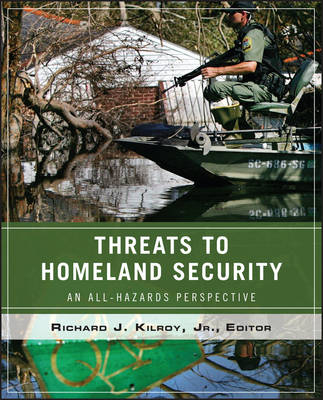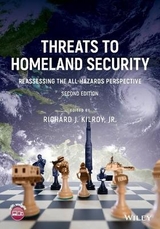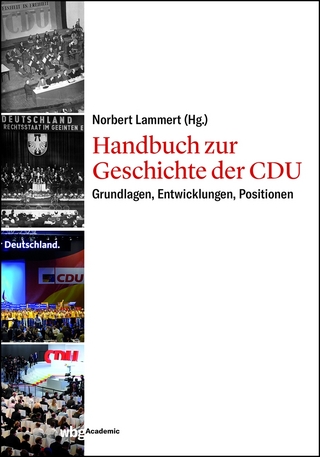
Wiley Pathways Threats to Homeland Security
John Wiley & Sons Ltd (Verlag)
978-0-470-07398-8 (ISBN)
- Titel erscheint in neuer Auflage
- Artikel merken
1 The Changing Nature of National Security 1
Introduction 2
1.1 Foundations of American Security Policy 2
1.1.1 Geopolitics at the Beginning of the Twentieth Century 3
1.1.2 National Security and World War II 5
Self–Check 8
1.2 Security in the Cold War Era 8
1.2.1 Bipolarity vs. Multipolarity 10
1.2.2 Containing Communism 12
1.2.3 Non–Communist Threats 17
Self–Check 18
1.3 Security in the Post Cold War Era, Pre–9/1118
1.3.1 Changing Threats 18
1.3.2 New Conflicts, New Responses 19
1.3.3 Reorganization of National Security Policy 21
Self–Check 22
1.4 Security in the Global War on Terrorism, Post–9/11 22
1.4.1 Globalization and Geopolitics 23
1.4.2 Reorganization for the Global War on Terrorism 25
Self–Check 28
Summary 28
Key Terms 29
Summary Questions 32
Applying This Chapter 33
You Try It 34
2 U.S. Homeland Security Interests 35
Introduction 36
2.1 Human Security: Protecting People 36
2.1.1 Social Factors 38
2.1.2 Political Factors 40
Self–Check 48
2.2 Critical Infrastructure and Key Resources 48
2.2.1 Major Initiatives 50
2.2.2 Types of Protection 53
Self–Check 55
2.3 Economic Pressures and Activities 56
2.3.1 Protecting the U.S. Economy 56
2.3.2 Economic Recovery After an Incident 57
2.3.3 The Costs of Homeland Security 58
Self–Check 62
2.4 Societal Values: Protecting Democracy 62
2.4.1 A Controversy as Old as Our Country 63
2.4.2 The Bill of Rights and Constitutional Issues 63
Self–Check 67
Summary 67
Key Terms 67
Summary Questions 71
Applying This Chapter 72
You Try It 73
3 The All–Hazards Perspective 74
Introduction 75
3.1 Natural Disasters: Things We Can Expect to Happen 75
3.1.1 The History of Natural Disasters in the United States 76
3.1.2 Natural Disaster Response 78
3.1.3 Natural Disasters in a Post–9/11 World 80
Self–Check 82
3.2 Accidental Hazards: Things We Can Try to Prevent 82
3.2.1 History of Accidental Hazards in the United States 83
3.2.2 Accidental Hazard Prevention and Response 84
3.2.3 Accidental Hazards in a Post–9/11 World 87
Self–Check 88
3.3 Man–made Hazards: Things We Hope Don t Happen 88
3.3.1 History of Man–made Disasters Caused by Human Error in the United States 89
3.3.2 Man–made Disaster Mitigation and Response 90
3.3.3 Man–made Disasters in a Post–9/11 World 92
Self–Check 93
Summary 93
Key Terms 94
Summary Questions 97
Applying This Chapter 98
You Try It 99
4 A Conceptual Framework Assessing Threats and Interests 100
Introduction 101
4.1 A General Framework of Analysis What to Assess 101
4.1.1 The Disaster Impact Process 102
4.1.2 Pre–Impact Conditions 103
4.1.3 Event–Specific Conditions 106
4.1.4 Final Thoughts on What to Assess 107
Self–Check 108
4.2 A Matrix Approach How to Assess 108
4.2.1 Risk Matrices 110
4.2.2 Composite Exposure Indicator 112
4.2.3 HAZUS 114
4.2.4 Vulnerability Assessments 115
4.2.5 Final Thoughts on How to Assess 116
Self–Check 117
4.3 The Emergency Management Planning Model 117
4.3.1 Mitigation 117
4.3.2 Risk Reduction 119
4.3.3 Preparedness 120
4.3.4 Response 120
4.3.5 Recovery 123
Self–Check 124
Summary 125
Key Terms 125
Summary Questions 128
Applying This Chapter 129
You Try It 130
5 State Actors and Terrorism 131
Introduction 132
5.1 Defining Terrorism 132
5.1.1 The Historical Context of Terrorism 134
5.1.2 Terrorism and Political Violence 135
Self–Check 136
5.2 States and the Use of Force in the Inter–State System 136
5.2.1 The State and the Use of Force 137
5.2.2 The State and Intervention 138
Self–Check 140
5.3 State Actors: What Is State Terrorism? 140
5.3.1 Internal State Terrorism 140
5.3.2 External State Terrorism 143
Self–Check 145
5.4 The Global Response 145
5.4.1 The United Nations and Collective Security 145
5.4.2 The United Nations Response to Terrorism 147
Self–Check 149
5.5 The United States and State Sponsors of Terrorism 149
5.5.1 Cuba 150
5.5.2 Iran 152
5.5.3 Libya 154
5.5.4 North Korea 155
5.5.5 Sudan 155
5.5.6 Syria 156
Self–Check 158
5.6 Implications of the U.S. Response to State–Sponsored Terrorism 157
5.6.1 Criticisms of the State–Sponsored List 158
5.6.2 How Can the State Sponsor List Be Improved? 160
Self–Check 162
Summary 163
Key Terms 163
Summary Questions 165
Applying This Chapter 166
You Try It 167
6 Non–State Actors and Terrorism 168
Introduction 169
6.1 Non–State Terrorism and Its Impact on the Inter–State System 169
6.1.1 The Threat of Non–State Terrorism to a State 171
6.1.2 History of Ideas Underpinning Terrorist Movements 173
6.1.3 The Internationalization of Terrorism 176
6.1.4 The Meaning Behind the Internationalization of Terrorism 177
Self–Check 179
6.2 Different Types of Terrorist Organizations 179
6.2.1 Ethno–Nationalist/Separatist Terrorism 180
6.2.2 Ideological Terrorism 182
6.2.3 Religious Terrorism 187
Self–Check 192
6.3 Terrorist Methods 193
6.3.1 Primary Tactics of Terrorism 193
6.3.2 Use of Weapons of Mass Destruction 194
6.3.3 Suicide Terrorism 197
Self–Check 202
6.4 Counter–terrorism Efforts 202
6.4.1 Counter–terrorism Against Ethno–Nationalist/Separatist and Ideological Terrorism 203
6.4.2 Counter–terrorism Against Religious Terrorism 205
6.4.3 Counter–terrorism Against Suicide Terrorism 208
Self–Check 211
Summary 211
Key Terms 212
Summary Questions 214
Applying This Chapter 215
You Try It 216
7 Cyber–Terrorism and Cyber–Warfare 217
Introduction 218
7.1 The Cyber–Terrorism Threat 218
7.1.1 Defining Cyber–Terrorism and Cyber–Warfare 220
7.1.2 What Can Cyber–Terrorism and Cyber–Warfare Do? 221
Self–Check 224
7.2 Assessing Capability and Intent 224
7.2.1 Who Can Conduct Cyber–Terrorism and Cyber–Warfare? 225
7.2.2 Tools of Cyber–Terrorism 228
Self–Check 230
7.3 Assessing Consequences 230
7.3.1 Why America Is Vulnerable to Cyber–Terrorism 231
7.3.2 The Impact of a Cyber–Terrorist Attack 232
Self–Check 234
7.4 Determining Defenses Against Cyber–Terrorism and Cyber–Warfare 234
7.4.1 The Government and Private Sector Response to Cyber–Terrorism 237
7.4.2 The U.S. Military Response to Cyber–Warfare 240
Self–Check 244
Summary 244
Key Terms 245
Summary Questions 247
Applying This Chapter 248
You Try It 249
8 Weapons of Mass Destruction 250
Introduction 251
8.1 Chemical Weapons and Their Consequences 251
8.1.1 History of Chemical Weapons Use 251
8.1.2 Chemical Agents and Their Effects 252
8.1.3 The Threat of Chemical Weapons and Terrorism 253
Self–Check 255
8.2 Biological Weapons and Their Consequences 256
8.2.1 History of Biological Weapons Use 256
8.2.2 Biological Agents and Their Effects 258
8.2.3 The Threat of Biological Weapons and Terrorism 258
Self–Check 260
8.3 Radiological Weapons and Their Consequences 260
8.3.1 Radiological Materials and Their Effects 262
8.3.2 History of Nuclear Materials Discoveries and Weapons Development 265
8.3.3 The Threat of Nuclear Weapons and Terrorism 267
8.3.4 Managing Radiological Incidents and Their Aftermath 269
Self–Check 271
Summary 271
Key Terms 272
Summary Questions 274
Applying This Chapter 275
You Try It 276
9 Domestic Terrorism 277
Introduction 278
9.1 Analyzing the Domestic Terrorist Threat 278
9.1.1 Overview of Domestic Terrorism 279
9.1.2 Homegrown Terrorists 280
9.1.3 Foreign Terrorists 284
9.1.4 Foreign Terrorist Organizers 286
9.1.5 Final Thoughts on the Domestic Terrorist Threat 288
Self–Check 289
9.2 The Operational Environment for Terrorism 290
9.2.1 The Physical Environment 290
9.2.2 The Political Environment 291
9.2.3 The Security Environment 294
9.2.4 The Resource Environment 296
9.2.5 Final Thoughts on the Operational Environment 298
Self–Check 298
9.3 The U.S. Response to Terrorism 299
9.3.1 The Lead Agency Approach and Counterterrorism 299
9.3.2 The Criminal Justice Approach 301
9.3.3 Final Thoughts on the U.S. Response to Terrorism 304
Self–Check 305
Summary 305
Key Terms 306
Summary Questions 309
Applying This Chapter 310
You Try It 311
10 Enablers of Mass Effects 312
Introduction 313
10.1 The Power of Information and Ideas 313
10.1.1 Ideas and Terrorism 317
10.1.2 Ideas and the All–Hazards Assessment 318
Self–Check 321
10.2 The Role of the Media in the Global War on Terrorism 321
10.2.1 The Use of Media by Terrorist Groups 322
Self–Check 324
10.3 The Internet and Other Global Communications Means 324
Self–Check 330
10.4 The Role of Educational Institutions 331
10.4.1 Alternative Educational Institutions 331
10.4.2 International Students in the United States 332
10.4.3 Education of Domestic Students in Security 333
Self–Check 335
Summary 335
Key Terms 336
Summary Questions 338
Applying This Chapter 339
You Try It 340
Bibliography 341
Glossary 358
Index 372
| Erscheint lt. Verlag | 28.3.2008 |
|---|---|
| Verlagsort | Chichester |
| Sprache | englisch |
| Maße | 187 x 230 mm |
| Gewicht | 570 g |
| Themenwelt | Sozialwissenschaften ► Politik / Verwaltung |
| ISBN-10 | 0-470-07398-5 / 0470073985 |
| ISBN-13 | 978-0-470-07398-8 / 9780470073988 |
| Zustand | Neuware |
| Haben Sie eine Frage zum Produkt? |
aus dem Bereich



